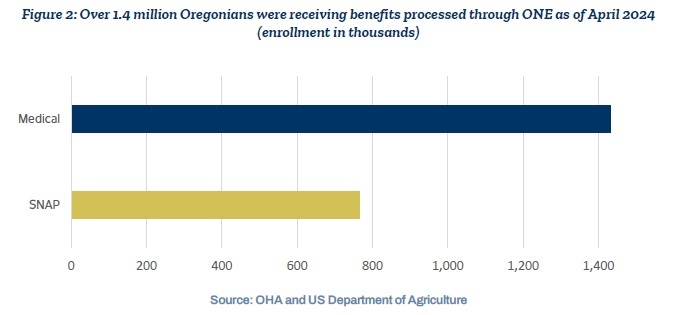SALEM, OR — Oregon’s multi-million-dollar system for determining eligibility for key public assistance programs is generally performing as it should, according to a new audit released today by the Oregon Secretary of State Audits Division.
The OregONEligbility System — otherwise known as ONE — is meant to provide a more streamlined way for Oregonians to apply for public assistance programs, such as the Supplemental Nutrition Assistance Program (SNAP, or food stamps) and Medicaid.
The system is a joint effort between two Oregon state agencies: the Oregon Health Authority (OHA) and the Oregon Department of Human Services (ODHS). ODHS uses the system to determine eligibility and benefit amounts for its SNAP program and to determine eligibility for the Medicaid program on behalf of OHA.
The efficacy of the system is critically important. The system determines eligibility for programs that provided more than $18 billion in benefits in fiscal year 2023, serving more than 1 million Oregonians with essential services like food stamps and health care coverage for children and families.

“This is a really critical system for the state — as important as any system could be,” said Audits Director Kip Memmott. “We did a very thorough audit because we know there’s some concern among state leadership about major IT investments and how well they function. I’m pleased to say there’s some good assurance we provide, that the automated part of the system is working well.”
Large IT systems like this one rely heavily on automated functions to ensure calculations are accurate and help staff process data more quickly. Auditors found that the automated eligibility determinations made in ONE are largely effective and accurate. While auditors did note some small errors, they either affected small populations or had no impact on eligibility determinations.
Despite best efforts, no IT system — automated or otherwise — is immune from human error. According to the audit, the minor eligibility determination errors that occurred were largely due to manual input errors. For example, in a test of 40 randomly selected SNAP cases, auditors found 11 cases where an input error resulted in an inaccurate benefit calculation.
Further complicating matters was the COVID-19 pandemic. Federal and state agencies adopted new rules to help more Oregonians who were affected by the pandemic, but these changes and the dynamic nature of the pandemic itself made the ONE system more complex and tricky to navigate.
Both ODHS and OHA have strategies in place to mitigate any human error, but auditors found ways the agencies could strengthen these controls. ODHS, responding to recommendations on behalf of both agencies, agreed with all three of the audit’s recommendations.

